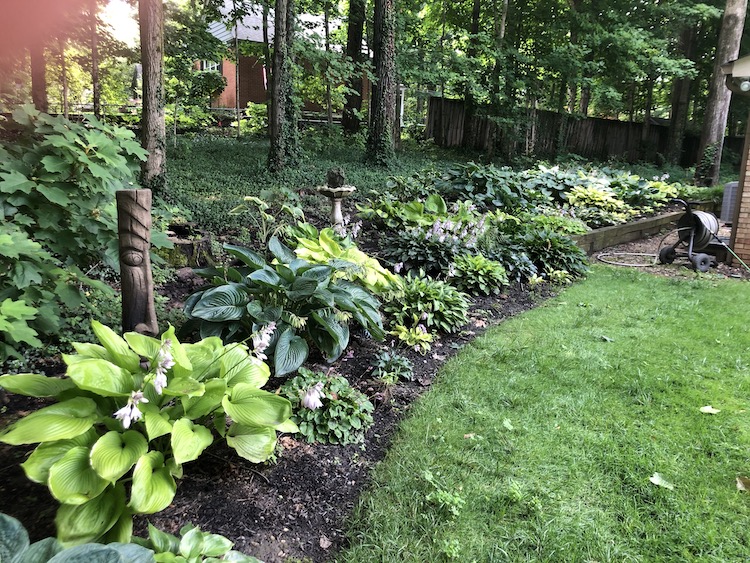Coaching stints reveal common problems in Indiana landscapes. Plants too big for their space is one. But there are others. Here are some things to keep in mind when working in your landscape.
One is the Loneliest Number
Avoid planting in onesies. Onesies are great for infants but not so fashionable for perennials or annuals. For a solid presentation, plant in clusters of uneven numbers, such as three, five, seven. Most of the time, a grouping the three gets the job done. If you planted onsies to carry a color or plant through the garden, repeat that idea with the groupings. Doing that also will create a cohesive and showy garden. I was coaching in a garden recently that carried out this design beautifully. Throughout a long shady bed, the gardeners planted chartreuse hosta, which guides your eye through the space.

Too Close for Comfort
Many gardeners think one way to camouflage the foundation of their home is to plant in front of it. Definitely, planting in front of the foundation is the way to go. But not right in front. Come out a minimum of 18 inches or more from the foundation before planting. This recommendation applies to trees, shrubs or perennials.
Moving plants a couple feet from the foundation accomplishes what you want…covering the foundation. It also allows for what’s called a maintenance alley, where you can go to wash windows, paint or maybe even get to the spigot and hose. And it moves the plants out from under an overhang, where rain usually doesn’t hit.

Tight Fit
This means making sure you know the height and width of the space where you want to plant trees and shrubs. Many people just look at the height without considering the width.
That’s why so many trees and shrubs are bare on one side because they are too close to the house or garage. Or the plants grow to cover a walkway, driveway or steps.
Another garden I was in was planted with a river birch about 2 feet from the house. The mature size of a river birch is between 40 to 70 feet tall and 40 to 60 feet wide. Of course, I suggested the gardener move the plant.
Here’s how to determine how much width to allow a plant:
- What is the mature width of the plant?
- If it will be 8 feet wide at maturity, the center of the plant should be at least 4 feet from a structure, sidewalk or other area that could be blocked.
- When planting perennials or shrubs in a bed or to create a hedge, take the mature width and plant that distance from the center of one plant to the center of the next plant. So, if a coneflower will be 12 inches wide, plant the center of plant A12 inches from the center of plant B, the next coneflower.
- It never hurts to add an inch or two, if there’s space.
How Deep is Your Bed
The depth of a bed is the distance from a structure to the edge of the bed. Or, it’s the distance from one edge of the bed to the other. The distance from end to end is generally referred to as the length.
Most of us tend to make these beds too shallow. We think 2, or maybe 3 feet looks good. But when we plant those beds, plants of any size have no place to grow. I’d say the minimum is 5 feet deep. Six feet is even better. Having a bed 6 feet deep opens up a lot more plants to choose from. And remember, the bed’s 18 to 24 inches by the house can’t be planted. So, even with a bed 6 feet deep, you may only have 4 feet of actual planting space.
A Weed’s Delight
Bare soil is an open invitation for plants, usually weeds, to move right in. A plant’s goal is always to cover the soil, especially if we don’t. This brings us back to grouping plants, trying to fill every space, either with plants, mulch, chopped leaves or compost. Anything to cover the soil until more desirable plants can be added. In my own landscape, the beds that are tightly planted have the fewest leaves. Beds with open spaces get weeds. Lesson learned.
